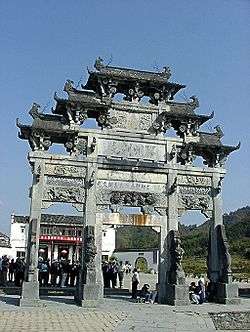Paifang
| Paifang | |||||||||||||||||||||||||
|
| |||||||||||||||||||||||||
| Chinese | 牌坊 | ||||||||||||||||||||||||
|---|---|---|---|---|---|---|---|---|---|---|---|---|---|---|---|---|---|---|---|---|---|---|---|---|---|
| Literal meaning | memorial archway gate | ||||||||||||||||||||||||
| |||||||||||||||||||||||||
| Pailou | |||||||||||||||||||||||||
| Simplified Chinese | 牌楼 | ||||||||||||||||||||||||
| Traditional Chinese | 牌樓 | ||||||||||||||||||||||||
| Literal meaning | memorial archway edifice | ||||||||||||||||||||||||
| |||||||||||||||||||||||||

A Paifang, also known as a pailou, is a traditional style of Chinese architectural arch or gateway structure that is related to the Indian Torana from which it is derived.[1]
Etymology
The word paifang (Chinese: 牌坊; pinyin: páifāng) was originally a collective term for the top two levels of administrative division and subdivisions of ancient Chinese cities. The largest division within a city in ancient China was a fang (坊; fāng), equivalent to a current day precinct. Each fang was enclosed by walls or fences, and the gates of these enclosures were shut and guarded every night. Each fang was further divided into several pai (牌; pái; "placard"), which is equivalent to a current day (unincorporated) community. Each pai, in turn, contained an area including several hutongs (alleyways).
This system of urban administrative division and subdivision reached an elaborate level during the Tang dynasty, and continued in the following dynasties. For example, during the Ming dynasty, Beijing was divided into a total of 36 fangs. Originally, the word paifang referred to the gate of a fang and the marker for an entrance of a building complex or a town; but by the Song dynasty, a paifang had evolved into a purely decorative monument.
Origin
It is suggested that the Chinese paifang may have been derived from the torana temple-gate in ancient India,[2] though it has taken on traditional Chinese architectural characteristics such as multi-tiered roofs, various supporting posts, and archway-shapes of traditional gates and towers.[3][4]
During the Tang dynasty, it was called a wutoumen (烏頭門; wūtóumén; "black top gate"), because the top of the two posts were painted black. A wutoumen was reserved for officials of rank 6 or higher.
The construction of wutomen was standardized in the Yingzao Fashi of the mid Song dynasty.[5] It consisted of two posts and a horizontal beam forming a frame and two doors. By the Ming and Qing dynasties, it was called a pailou or paifang, and evolved into a more elaborate structure with more posts and gates, with a superstructural gable on top; the highest rank was a five gate-six post-eleven gable pailou.
Style
Paifangs come in a number of forms. One form involves placing wooden pillars onto stone bases, which are bound together with wooden beams. This type of paifang is always beautifully decorated, with the pillars usually painted in red, the beams decorated with intricate designs and Chinese calligraphy, and the roof covered with coloured tiles, complete with mythical beasts—just like a Chinese palace. Another form of paifang is in the form of true archways made of stone or bricks; the walls may be painted, or decorated with coloured tiles; the top of the archways are decorated like their wooden counterparts. Yet another form of paifang, built mainly on religious and burial grounds, consists of plain white stone pillars and beams, with neither roof tiles nor any coloured decoration, but feature elaborate carvings created by master masons. Another form is in the Han dynasty style, and is two matching towers, such as in Beihai.
Outside of China, the paifang has long been the symbol of Chinatowns. The largest outside of China can be found at Washington D.C.'s Chinatown.
In the past, "Chastity Paifangs" were given to widows who remained unmarried till death, praising what was seen as loyalty to their deceased husbands.
Gallery
_from_Han_Dynasty_(202_BCE_%E2%80%93_220_CE)_across_a_Street_Lined_with_Small_Shops._Hanzhong%2C_Shaanxi_Province%2C_China%2C_1875_WDL2092.png) Ornamental Gateway (Pailou) from Han Dynasty (202 BCE – 220 CE) across a Street Lined with Small Shops. Hanzhong, Shaanxi Province, China, 1875 WDL2092
Ornamental Gateway (Pailou) from Han Dynasty (202 BCE – 220 CE) across a Street Lined with Small Shops. Hanzhong, Shaanxi Province, China, 1875 WDL2092
 A paifang photographed in Gansu Province (1933).
A paifang photographed in Gansu Province (1933).- Paifang of Wuhan University (1920).
- Paifang at the Cemetery of Confucius, tomb of Lady Yu, wife of Kong Xianpei (72nd generation) in Qufu, China.
- Paifang in the Chiang Kai-Shek Memorial Square (now Liberty Square) in Taipei.
 Decorated paifang at the Summer Palace in Beijing.
Decorated paifang at the Summer Palace in Beijing.
 Colour glaze gateway at Puotuo Zongcheng temple, Chengde.
Colour glaze gateway at Puotuo Zongcheng temple, Chengde. Paifang in Xidi.
Paifang in Xidi. Paifang at the entrance to Chinatown in Boston, Massachusetts. This paifang was a gift from Taiwan[6]
Paifang at the entrance to Chinatown in Boston, Massachusetts. This paifang was a gift from Taiwan[6] Friendship Gate in the Chinatown of Washington, D.C.
Friendship Gate in the Chinatown of Washington, D.C. Pailou at Dunedin Chinese Garden, New Zealand.
Pailou at Dunedin Chinese Garden, New Zealand.- Pailou at the entrance to Qiandao Lake Scenic Area
 Paifangs at the entrance to Yonghe Temple, Beijing
Paifangs at the entrance to Yonghe Temple, Beijing- Pailou at the China Martial Arts Hall, Jinshitan, Dalian
See also
| Wikimedia Commons has media related to Paifang. |
- Chinese architecture
- Chinese culture
- Chinatown
- Torana
- Torii
- Hongsalmun
- Ruins of St. Paul's Cathedral, Macao
- Triumphal arch
References
- ↑ A.H. Longhurst (1995). Story Of The Stupa. Asian Educational Services. pp. 17–. ISBN 978-81-206-0160-4.
- ↑ Joseph Needham, Science and Civilization in China, Vol 4 part 3, p137-138
- ↑ Ronald G. Knapp (2000). China's old dwellings. University of Hawaii Press. p. 85. ISBN 0-8248-2214-5.
- ↑ Simon Foster; Jen Lin-Liu; Sharon Owyang; Sherisse Pham; Beth Reiber; Lee Wing-sze (2010). Frommer's China. Frommers. p. 435. ISBN 0-470-52658-0.
- ↑ Li Jie. "The Construction of Wutoumen". Yingzao Fashi 營造法式. 6: Minor Woodwork I.
- ↑ http://www.boston.com/yourtown/boston/downtown/gallery/chinatown_tour/
.jpg)